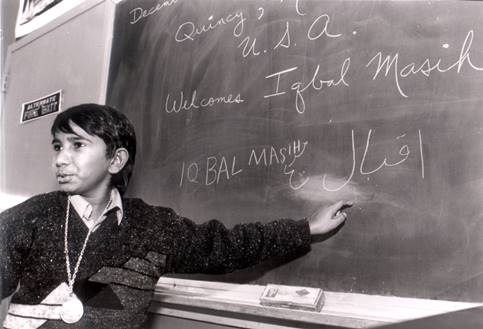Our Vision
GoodWeave’s vision is a world free of child labor.
Letter from the CEO
Dear Friends,
Many people have an “epiphany” story—a story about an event or an experience that changed everything for them. Mine came in the form of a magazine article about a little boy named Iqbal Masih.
Sold into bondage by his family at the age of four, Iqbal managed to escape slavery in a Lahore carpet shed to become the international face of child labor in the 1990s. Iqbal was only 10 years old when he bravely risked everything to break free from his servitude and attend a school specially designed for former child slaves; while there, he resolved to use his experience and education to alert the world about the everyday horrors surrounding child labor, and to do whatever he could to help children like him avoid its misery.
He was in the midst of carrying out this mission—traveling to Europe and the United States with support from the Reebok Human Rights Award, sharing his story, speaking out—when he was murdered in his home country of Pakistan in 1995, almost certainly in retaliation for his activism. He was 12 when he died.
In 1999, I came across a magazine feature relaying the details of Iqbal’s short, heroic, and inspirational life. The article moved me profoundly. At the end of it, mention was made of an organization continuing Iqbal’s legacy by identifying, monitoring, and certifying South Asian carpet-weavers who had committed to manufacturing their rugs without the use of child labor. That organization is now known as GoodWeave; and even though I couldn’t possibly have foreseen it on the day I learned of its existence, I would end up going to work there just a few months later, eventually becoming its chief executive officer.
For nearly three decades, GoodWeave has been fighting to end child labor on several different fronts: widening the ambit of its original rug certification program to include ever more partners up and down the supply chain; raising awareness of the issue among consumers, importers, exporters, retailers, and designers; reducing prevalence in the carpet industry by 80 percent and directly rescuing children from their looms, and from lives of servitude.
We’ve met with much success. But until such bondage is a thing of the past, we can’t claim to have finished the job that we set out to do. We want to see child labor disappear permanently. That’s one reason that we’re now opening up a new front in this battle: taking our proven model into other sectors, and replicating its success there. Today, GoodWeave is strategically expanding its reach to include other industries that have been marked by the scourge of child labor. This human tragedy can be eradicated and children all over the world can be free to learn, play, and grow: the inalienable right of every child.
I still think about Iqbal, and am filled with sadness every time I do. But there are other stories, newer ones, that fill me with hope. I also think about Sanju: a smart, vibrant, reflective girl whom we rescued from a carpet factory in Nepal, where she had been sent to work at the age of 11—for 16 hours a day, seven days a week. After her rescue, Sanju and her family were the victims of not one but two devastating earthquakes, which destroyed homes and schools in her village. Sanju’s distraught parents turned to GoodWeave for help, and within a week’s time we were able to find a spot for her in one of Nepal’s best schools while her parents and her community tried to rebuild.
Iqbal’s story affected many people, including me, my GoodWeave colleagues, and our organization’s many partners and supporters. And it continues to echo in the work that we do—shaping the outlooks and outcomes of other stories, like Sanju’s.
With your help, we can rewrite the stories for millions of children—one happy ending at a time.
Sincerely,
![]()
Nina Smith CEO

Iqbal Masih
